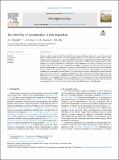Files in this item
The reliability of pseudoneglect is task dependent
Item metadata
| dc.contributor.author | Mitchell, A. G. | |
| dc.contributor.author | Harris, Julie | |
| dc.contributor.author | Benstock, S. E. | |
| dc.contributor.author | Ales, Justin Michael | |
| dc.date.accessioned | 2020-09-16T14:30:02Z | |
| dc.date.available | 2020-09-16T14:30:02Z | |
| dc.date.issued | 2020-11 | |
| dc.identifier | 269824667 | |
| dc.identifier | 1e455ba8-2804-4319-89b5-9de3f3794ce5 | |
| dc.identifier | 85090836943 | |
| dc.identifier | 000595875700010 | |
| dc.identifier.citation | Mitchell , A G , Harris , J , Benstock , S E & Ales , J M 2020 , ' The reliability of pseudoneglect is task dependent ' , Neuropsychologia , vol. 148 , 107618 . https://doi.org/10.1016/j.neuropsychologia.2020.107618 | en |
| dc.identifier.issn | 0028-3932 | |
| dc.identifier.other | ORCID: /0000-0002-3497-4503/work/80257393 | |
| dc.identifier.uri | https://hdl.handle.net/10023/20632 | |
| dc.description | Funding: This work was supported by the University of St. Andrews and by Wellcome Trust Institutional Strategic Support Funds (105621/Z/14/Z). | en |
| dc.description.abstract | Bisection tasks that require individuals to identify the midpoint of a line are often used to assess the presence of biases to spatial attention in both healthy and patient populations. These tasks have helped to uncover a phenomenon called pseudoneglect, a bias towards the left-side of space in healthy individuals. First identified in the tactile domain, pseudoneglect has been subsequently demonstrated in other sensory modalities such as vision. Despite this, the specific reliability of pseudoneglect within individuals across tasks and time has been investigated very little. In this study, we investigated the reliability of response bias within individuals across four separate testing sessions and during three line bisection tasks: landmark, line bisection and tactile rod bisection. Strong reliability was expected within individuals across task and session. Pseudoneglect was found when response bias was averaged across all tasks, for the entire sample. However, individual data showed biases to both left and right, with some participants showing no clear bias, demonstrating individual differences in bias. Significant, cross-session within-individual reliability was found for the landmark and tactile rod bisection tasks respectively, but no significant reliability was observed for the line bisection task. Alongside this, no significant cross-task within-individual reliability was observed. These results highlight the inconsistent nature of pseudoneglect within individuals, particularly across sensory modality. They also provide strong support for the use of the landmark task as the most reliable measure of pseudoneglect. | |
| dc.format.extent | 10 | |
| dc.format.extent | 3340010 | |
| dc.language.iso | eng | |
| dc.relation.ispartof | Neuropsychologia | en |
| dc.subject | Pseudoneglect | en |
| dc.subject | Attention | en |
| dc.subject | Perception | en |
| dc.subject | Reliability | en |
| dc.subject | BF Psychology | en |
| dc.subject | RC0321 Neuroscience. Biological psychiatry. Neuropsychiatry | en |
| dc.subject | DAS | en |
| dc.subject.lcc | BF | en |
| dc.subject.lcc | RC0321 | en |
| dc.title | The reliability of pseudoneglect is task dependent | en |
| dc.type | Journal article | en |
| dc.contributor.sponsor | The Wellcome Trust | en |
| dc.contributor.institution | University of St Andrews. Institute of Behavioural and Neural Sciences | en |
| dc.contributor.institution | University of St Andrews. School of Psychology and Neuroscience | en |
| dc.identifier.doi | https://doi.org/10.1016/j.neuropsychologia.2020.107618 | |
| dc.description.status | Peer reviewed | en |
| dc.identifier.grantnumber | 105621/Z/14/Z | en |
This item appears in the following Collection(s)
Items in the St Andrews Research Repository are protected by copyright, with all rights reserved, unless otherwise indicated.

